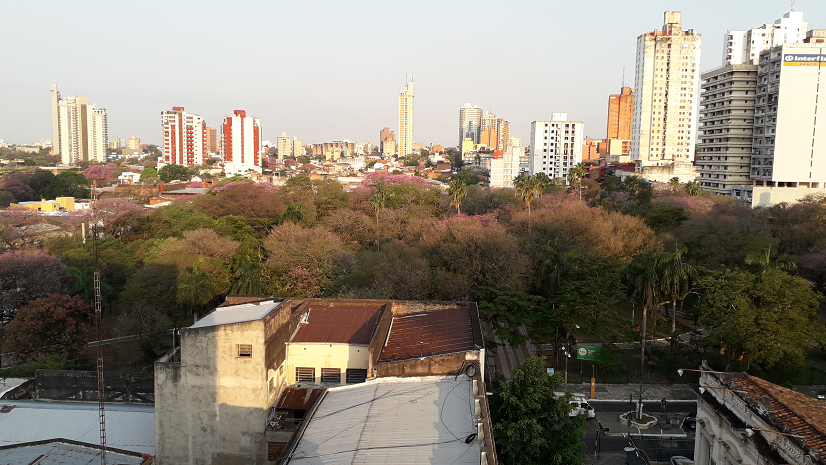Asuncion is the capital of Paraguay and by far its largest city. Almost half the population make their homes within Asuncion and its suburbs. Despite this the city remains a very green one.
Looking down upon Asuncion from a high building is soon becomes clear just how green the city is. In every direction the trees look as numerous as the buildings.
Nature and the natural world has a home in almost every corner of Asuncion. From roadside trees to city parks.
Many of the trees are evergreen. So even on a cold winter day the city puts on its green face.
Throughout the city there are avenues lined with trees. Some may be small and ornamental grand old structural trees but all add life to the city streets. Along some roads the trees offer their fruits of orange or mango to the passerby when the season is right.
In all places though they throw shade across the pavements sheltering pedestrians from the glare of the tropical sun. And in a city where in many places the road network was designed for a quieter age they offer some protection from the pollution the jammed traffic produces.
The oldest and grandest of these roadside trees where growing before the roads were tarmaced and before there was motorized traffic. In a number of places I have come across an old established tree growing in the middle of a road with barely room for a car to pass on either side.
On more recently laid out streets the trees will probably all match and form a whole where as in older parts of town what is growing reflects what has always grown there.
It is not though just the pavements that wear this green mantle. The people of Asuncion like everyone across Paraguay enjoy and expect their parks and plazas.
All across the city there are patches of land which might otherwise have become blocks of housing but are instead tree filled plazas. In the historic center in particular you are never beyond walking distance of a plaza of some shape or size.
The smallest just occupy one block within the grided network of streets but others fill several. All though are places of calm and tranquility. Somewhere to step to escape the bustle of the city.
All are coated in soft green grass. Through them pathways travel. These may meander or may be driven as straight as a city street. All though are crossed by well defined paths.
Along these paths sit benches. Somewhere to sit and read a newspaper or to just watch the world go by. Within the plazas are also statues. Sometimes just one as a focal point to the plaza and sometimes whole collections.
Above all this are the trees. Lapacho, palms and many others. Every plaza is filled with a multitude of trees providing cooling shade to all that is below. At times the trees are filled with bright flowers. Asuncion is a riot of colour every spring when the lapachos are in bloom.
Larger and greener still than the plazas are the city parks of Asuncion.
There are a number of parks just outside the city center between it and the Bay of Asuncion. Some of these like Parque Caballero have existed for many years. Others were laid out more recently when the boulevard of the Costanera was placed along the waters edge.
This wide green expanse now separates the noise of the city from the calm of the bay.
Further out from the city center is the largest park of all. The 250 hectares of the Botanical Garden. Here in what was once the private park of 19th century presidents is an oasis of calm.
The park is filled with many large and mature trees. Between them are winding pathways which soon take visitors into the woodlands. Markers show the way ensuring that no one gets lost and that a walk of a suitable length can be selected.
The lawns beneath the trees are an ideal place to take a picnic whilst children run off their energy with a ball game. For those wanting their sport a little more organized a couple of football pitches have been marked out.
All in all despite its urban sprawl and traffic clogged rush hour streets in Asuncion you are never far from nature and something natural.
A city it is but not one that has swept away all sign of what was there before the streets and houses came.


Amazing! This blog looks exactly like my old one! It’s on a completely different subject but
it has pretty much the same layout and design. Excellent choice of colors!